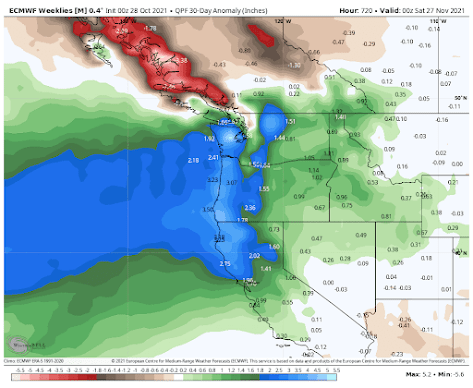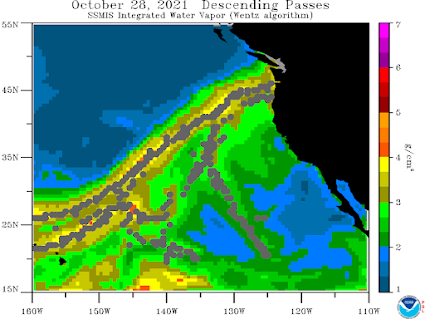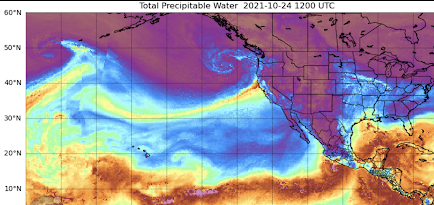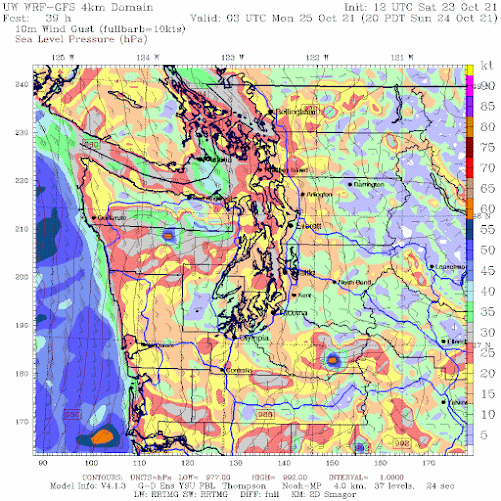The ancient Romans believed that rainfall was controlled by the great god Jupiter....or to be more exact, one of the aspects of the deity, Jupiter Pluvius.
Even in modern times, some folks would suggest that drought was associated with sleeping god:This blog discusses current weather, weather prediction, climate issues, and current events
October 31, 2021
Pluvius Jupiter Reigns over the Northwest
October 29, 2021
Why are there atmospheric rivers? And a very pleasant weekend ahead. All in my lates podcast!
Atmospheric rivers bring plumes of moisture to the West Coast and often heavy precipitation.
But why do atmospheric rivers exist? What conditions create them?
All is revealed in my latest podcast (see below).
And the podcast also provides the forecast for the next week, including the critical day of Halloween when little goblins are making their rounds.
You can listen to the podcast below or through your favorite podcast server.
_____________________________________________
October 28, 2021
A River Runs Through Us
Today was a very wet day over Washington State and southern British Columbia.
And you can blame a river...an atmospheric river of moisture streaming out of the subtropics for most of the wet action.
A model forecast of the amount of water vapor in a vertical column of air, valid at 8AM this morning, shows a "juicy" plume heading right into the Northwest.
And the visible satellite image this afternoon shows a plume of clouds associated with the moisture river. A front is found at the southern edge of the cloud mass....the brighter white clouds indicated by the red arrow.
When the atmospheric river hits our mountains, it is forced to rise, releasing massive amounts of precipitation. The UW model total precipitation forecast for the 24h ending 5 AM tomorrow morning (below) is impressive, with as much as 5 inches at higher elevations and even a few inches at some lowland locations.
You are probably wondering, how much did we get today so far? Here are the numbers (for the 24 h ending at 7 PM).
We have already received 4-5 inches on the windward (southwest) side of the Olympics and the western slopes of the North Cascades.
October 26, 2021
Is California Experiencing More "Weather Whiplash"?
---John Steinbeck, East of Eden
___________________________________________________________
After the heavy rains of the past few days over central and northern California, a number of media outlets are talking about California suffering from "Weather Whiplash", since the record precipitation this autumn follows a year of drier than normal conditions.
And several media outlets are going much further, claiming the the "whiplash" is the result of climate change and is worsening over time (see below). Such articles quote from scientists whose research suggested increasing whiplash based on their examination of climate model projections.Well, what is the truth?
Global warming has been significant for several decades so we should see evidence of increasing "whiplash" if climate change is a major forcing mechanism. Strangely, none of the handful of studies in the scientific literature on whiplash has looked at the observational record. Just the climate models.
But in this blog, the analysis will be done!
Let's examine the NOAA/NWS climate division data for California, and specifically, the precipitation for California's wet season of November through March from 1900 through 2021 (see below).
One is struck by several things.
There is really not much trend in California's winter precipitation.
And there is a lot of up and down variability---yes, weather whiplash. But there does not seem to be any long-term trend for more or less precipitation whiplash.
To illustrate this point, let's plot the yearly whiplash...a WHIPLASH INDEX.. by simply taking the difference between each year's and the previous year's winter precipitation for California. Since we don't care which way the whiplash goes (wet to dry or dry to wet), I will plot the absolute value of the difference. I also plotted (red dots), a 10-year moving average to smooth out the variation over time (see below).
Really very little long-term trend in California precipitation whiplash, with the worst of it from roughly 1975 to 1997.
Will whiplash get worse in the future?
I am involved in regional climate simulations, using an ensemble of high-resolution projections driven by an ensemble of many global climate models. This is the gold standard for such work. We ran these simulations using the highly aggressive RCP 8.5 scenario for increasing greenhouse gases, which is certainly not realistic since it assumes that mankind keeps on burning increasing amounts of coal, among other things.
Below are the results for Red Bluff in northern California (winter precipitation) through 2100, with the green lines being the average of the many forecasts. During the end of the century, there is perhaps some suggestion of occasionally larger whiplash, but also extended periods of less whiplash. But again, the amount of CO2 emissions is undoubtedly too large.
I think the jury is still out on whether California whiplash will increase significantly during the second half of this century. And the research studies that have suggested big increases during this century also predicted major whiplash increases during the past two decades. These have not verified with observations.October 24, 2021
A Record Storm and the Power Outages Begin
This morning, the offshore storm rapidly intensified and achieved record status, with the central pressure dropping to at least 943 hPa (the previous record for our region was 950 hPa).
And there is a very good chance it is even deeper right now.
Here is the latest visible satellite image of the storm (around 10 AM).
Stunningly beautiful creature, with the frontal clouds swirling towards the low center. And you can see very unstable air with lots of convection (e.g., thunderstorms) over the southwest portions (the popcorn-looking clouds). Some of that activity will reach us later today.
The official National Weather Service analysis indicated 943 hPa at 8AM (see sea level pressure map below)
October 23, 2021
The Storm's Future is Now Known
The models have converged to a consistent solution, the storm is beginning to "bomb", and I can now provide a forecast with some confidence.
This will be the strongest Northwest storm on record, but its strength will collapse as it approaches the coast of Vancouver Island. More quickly than any storm in my experience.
And there will be strong winds over land, but not from the south, but from the east, as air is pulled westward by the immense, powerful storm offshore.
Let me begin by showing you the latest water vapor satellite image over the eastern Pacific (below), with the dark areas indicating dry conditions.
This is a very potent storm, with massive clouds and extreme darkening, which indicates strong sinking behind the low center (you can see the moisture curling up). Such sinking is a sign of vigor.
Both the American (GFS) and European Center (ECMWF) models indicate very rapid intensification over the next 24h, with the storm catching down to around 943 hPa (see below for 8 AM Sunday). This is a "bomb" cyclone, with the pressure dropping more than 24 hPa in 24 hours.
Both U.S. and European modeling systems predict massive swell/waves approaching the West Coast from this monster storm, reaching 30 feet on Sunday evening!
Both modeling systems indicated that the storm will very rapidly weaken on Monday, making landfall on Vancouver Island with a central pressure around 985 hPa (see US model forecast below) at 11 PM Monday.
A Guaranteed White Christmas (In the Mountains)
For lovers of Northwest snow, I have good news. Bountiful mountain snow is GUARANTEED before Christmas. Yes, this means you will be able t...

-
In act one of this meteorological drama, yesterday and this morning brought heavy rain and flooding to many sections of western Washington. ...
-
The heavy rainfall is over, but some rivers are still rising. The most impactful atmospheric river event of the past few decades. Consider...

















































